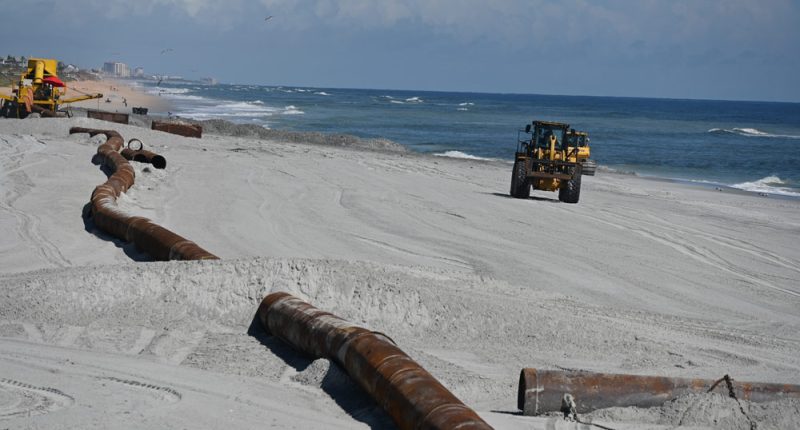
Flagler County government’s proposed $114 million plan to rebuild, maintain and protect 18 miles of shoreline over the next six years depends on raising the local sales tax by half a penny, imposing a $160-a-year tax on each barrier island property, including Flagler Beach, doubling spending on the beach from the county’s tourism-tax revenue, and temporarily using some general fund revenue toward the effort.
The plan requires more of a political than a financial buy-in from Palm Coast, Flagler Beach, Bunnell, Beverly Beach and Marineland. Aside from the barrier-island tax, or fee, it makes no demands on the cities’ property-tax revenue. But it would require Flagler Beach, Beverly Beach and Marineland to cede to beach management all their share of the revenue from the new half-cent sales tax, and require Palm Coast and Bunnell to ceded half their share of that revenue. The cities’ share of the current sales tax would not be affected.
At a joint meeting of local governments on Feb. 5 Palm Coast and Beverly Beach, and to some extent Flagler Beach, bluntly rejected the county’s request for financial help to rebuild and maintain Flagler County’s beaches. County officials at that meeting said they had a financial plan to get it all done. But they did not present it. (See: “Eroding Management Plan, Cities Bluntly Tell Flagler County: Not One Extra Dime for Beach Protection.”)
County Administrator Heidi Petito and Deputy County Administrator Jorge Salinas now have that plan down to the dollar. Petito and Salinas presented the plan to the Marineland Town Commission last Thursday. They are presenting it to the Bunnell City Commission tonight, the Palm Coast City Council on Tuesday, and the Flagler Beach City Commission on Thursday. The County Commission has yet to see it as a commission. But the plan, Petito said, is the result of the commission explicitly directing the administration to come up with concrete and pragmatic options to finance the county’s beach management while taking account of residents and municipalities’ resistance to new taxes.
The result is a thoughtful, detailed approach that attempts to balance the large financial cost of protecting the county’s primary economic asset–the beach–with local governments’ own burdens. The plan would relieve all the cities of any beach-management responsibility, especially Flagler Beach, making the county responsible for management of all 18 miles of shoreline. The county would carry the largest financial burden and the only managerial burden. But the varied funding mechanism seeks to spread some of the financial pain around through existing and novel means, while leaving all the cities’ property taxes (or general funds) untouched.
“As a county, people need to come together and support it,” Petito said of the plan. “Doing nothing is an option. Not a smart option, but it is an option.” So if the cities do not support the plan, the county will simply go ahead with rebuilding and maintaining the unincorporated part of the beach to the extent possible, which may not be as substantial as if the whole County was on board. As for Flagler Beach, its now beloved beach-renourishment section south of the pier, completed by the U.S. Army Corps of Engineers last summer, would be a one-off thing instead of a 50-year, ongoing project.
Maintaining that renourished beach is Flagler Beach’s responsibility. The city has yet to come up with a plan to do so, or to come up with part of the local match to fund the next round in 2030. The Petito plan gives the city an out. It makes the county responsible for it all.
If Flagler Beach declines, there is no money for the next beach nourishment round in Flagler Beach, due in 2030. The 50-year plan by the U.S. Army Corps of Engineers would just die. The beach would not be far behind.

The Petito plan has many layers and can seem complex, but broken down into its component parts, it’s rather straight-forward.
There are two components to beach management. Beach renourishment is one. That’s what’s often referred to as the “construction” part of rebuilding a beach–the literal dredging and dumping of new sand and rebuilding of dunes, the way the Army Corps did in Flagler Beach.
That phase would cost $42.4 million. It is necessary because since Hurricane Matthew, the beaches have been critically eroded in several parts, and without sea walls–which the state Department of Transportation has installed or is installing in two segments–erosion will continue, endangering A1A, which has been repeatedly bruised in severe storms, and flooding the barrier island, as was the case during Matthew, when dunes breached. The county cannot afford to lose the economic base of the island, Petito says, or else every local government’s services and quality of life would suffer.
“What we are trying to get back to is the pre-Matthew conditions,” the county administrator says. “Right now Flagler County is more vulnerable than when Hurricane Matthew hit,” she told the Marineland Town Commission. That may be true in some segments of the shoreline, but not in others–not in the Army Corps segment in Flagler Beach, for example, and not along the segment of northern Flagler Beach where the state built a seawall. Elsewhere, Petito is correct: the band-aid emergency sand dumps the county conducted since Matthew have themselves eroded.
The county would carry out that re-construction phase from north of the Flagler Beach pier all the way to Marineland. The cost for that phase is $42 million. The county is willing to shoulder the full cost. It would do so through its share of the existing sales tax, through tourist tax revenue, through the general fund, which would devote between $3.3 million and $3.9 million a year over the next three years to the plan, and through state and federal grants. The county already has $7.4 million of those pledged.
Doubling the tourism tax revenue for beach management may be a challenge, because it depends on re-allocating nearly $1 million a year, for just three years, from the tourism capital fund–which has funded grants for Palm Coast’s Southern Recreation center and Flagler Beach’s boardwalk reconstruction–to beach management only. That means there would be no grants for capital improvements for a while.
The cities might complain. But as far as rebuilding all the beaches are concerned, the cities would not have to put up a dime.
Then comes the maintenance part. That phase would cost $72.1 million. “We can do the construction but when it comes to maintenance, everyone has to have skin in the game,” Petito says.

That’s the part where the cities have to be more engaged. That’s the part that requires an additional $12 million a year, so there’s enough money to maintain the beach and accumulate savings for the next renourishment phase in staggered years, starting in 2030. That’s the part for which the Petito plan calls for an additional half-cent sales tax.
Flagler County is the last small county in Florida not to have that half-cent on its books. It would generate $10.6 million in 2026. Flagler County’s share would be $4.7 million, Palm Coast’s would be $5.4 million, Flagler Beach’s would be $277,000, and Bunnell’s $213,000. Beverly Beach would get $26,000 and Marineland less than $1,000.
Under the Petito plan, Flagler County would direct all of its share to beach management. It would require Flagler Beach, Beverly Beach and Marineland to turn over all their revenue from that half cent to the county. And it would require Palm Coast and Bunnell to turn over half: $2.7 million from Palm Coast, $107,000 from Bunnell. Both cities would still have more money than they have now, if they approve the plan.
The $160-a-year tax on barrier island properties would kick in in 2027.

The numbers are not set in stone, in the sense that state or federal grants could reduce the local commitment, and unexpected storms could raise the cost. “Each year we’re going to have to reevaluate this fund,” Petito said.
There are many more details to the plan (see the documents in the bullet points below). But in essence, that’s it. That’s the plan Petito is presenting to local governments, ahead of the next joint government meeting on March 12, when the county hopes to hear more positive responses from Palm Coast, Bunnell and Flagler Beach.
“At the end of the day I’d like to see everybody on board,” Petito said. But it won’t be up to her. It’ll be up to the elected officials and their sense of shared responsibility, assuming they see the beach as such. So far, that has not been the case.
The Plan in Details:
- Flagler County’s Coastal Erosion and Management: Comprehensive Report
- Flagler County’s Coastal Erosion and Management: Executive Summary
- Flagler County’s Coastal Erosion and Management: Slide Presentation to Local Governments

Click On:
- Flagler’s Officials Hope Congressman Mike Waltz Will Be Their Sandman as They Dredge for More Beach Dollars
- An Inside Look at the Army Corps’ Beach Renourishment Along Flagler County’s Shore as It Nears Completion
- Alarms Raised Over Beach Dredging Feared Close to Live Fishery Grounds, Endangering Soft Corals and Sea Life
- Sea Level Rise Make Florida’s ‘Beach Renourishments’ More Frequent, Expensive and Vain
- At ‘Monumental Groundbreaking’ for Beach-Rebuilding, Shovels of Praise, But Not a Word About Climate Change
- $27 Million Contract Awarded as 9-Month Dredging to Rebuild Beach North and South of Pier Starts in Weeks
- Some Hammock Residents Tell Flagler County: Tax Us for Beach Protection, and a Commissioner Sees Opportunity
- In Sharp Retreat, Flagler Rejects Countywide Beach Tax to Focus on Barrier Island Only, and on Informing Public
- Flagler Beach Demolishes Any County Plan To Make Barrier Island Pay Higher Tax for Beach Protection
- Document: Analysis of Taxing District for Beach Management Plan
- Document: Flagler County’s Beach Management Study
- For Flagler County, New Tax to Raise $7 Million a Year to Preserve Beaches Concedes Realities of Climate Change
- Flagler Seeks New Countywide Tax of Homes and Businesses for Beach Protection, But Cities’ Support Is Key
- ‘We Have a Deal’: Dune Hold-Out in Flagler Beach Concedes, Clearing Path to Renourishment
- Flagler County Accuses Dune Hold-Out of ‘Bad Faith’ and ‘Abomination,’ and Wants Property Seized
- In Stunning Revelation, Dune Hold-Out Had Filed for Bankruptcy–and Not Disclosed Parcels’ Value; County Now Has Leverage
- Nicole’s Damage to A1A ‘Much Worse’ Than Matthew, Over Longer Stretch; Parts of Flagler Beach Flood
- Catastrophic Loss: Dunes All But Gone Along Flagler’s 18-Mile Shore, Leaving A1A and Properties Dangerously Exposed
- What About Flagler Beach’s One Hold-Out Against Dune Fix? County Says December Deadline Will Be Met.
- Flagler Beach’s Tardy Dunes Project Is Down to a Single Holdout As Another Property Owner Signs Easement
- Raising $40,000 in 40 Hours, Flagler Beach Residents Throw Down Greenback Gauntlet to Dunes Project Hold-Outs
- Down to 11 Owners Holding Out, Army Corps May Decide on Aug. 19 Whether To Kill Dunes Project
- 15 Years On, $25 Million In, Flagler Beach Dunes Project Near ‘Dead In the Water’ as 13 Property Owners Hold Out
- ‘We’re Fighting For the Life of Flagler Beach’: County Urges Property Owners’ Cooperation in Beach Rebuilding
- With Little Transparency, County Approves $250,000 to Redesignate 12 Miles of Dunes as ‘Preservation Facility’
- Flagler About To Sign 50-Year, $100 Million Deal to Rebuild 2.6 Miles of Dunes in Flagler Beach. It Has Only a Fraction of the Money.
- Many Questions Remain as County and City Approve $100 Million, 50-Year Beach-Protection Plan in Flagler Beach
- Flagler’s Beach ‘Renourishment’ Is Exorbitant Futility
- In Big Win For Flagler Beach, U.S. Army Corps Awards$17.5 Million, Reviving Dunes Project
- How to Pay For Hurricane Irma’s Damages: Lawmakers (and Taxpayers) Face Billions in Costs
- Painters Hill and Hammock Dunes Property Owners Will Pay Extra Tax for Erosion Control
- Flagler County Walks Away From $35 Million In Beach-Repair Money: “It’s Them Abandoning Us”
- In Boost To Flagler, Committee Approves Bills Including $50 Million a Year For Beach Repair
- 12-Year Effort to “Renourish” Beaches All But Washes Out as County Urges Wall of Dunes Instead
- U.S. Corps’ Cost to Rebuild 2.5 Miles of Beach: $39 Million and Up, Storms Not Included
- Council Endorses Raising Flagler’s Tourism Tax to 5% to Pay For Beach Repairs
- Florida Climate Change Compact and Sea Level Projections
- Matthew and Irma Archives










